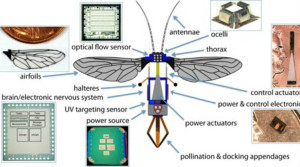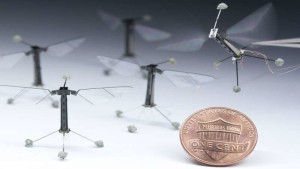This insect-sized flying robot is smaller than a quarter, 12 times lighter than a paperclip, and zips through the air with a pair of flapping wings. That’s not even the impressive part. Using a trick of electrostatic energy, the minuscule bot can efficiently cling to the underside of any flat surface, from tree leaves to glass skylights to your plaster ceiling. This electric-powered perching is almost effortless—it takes 1,000 times less energy than is needed to fly. The insectoid bot is called RoboBee, and was developed by a team of at MIT. RoboBee’s wings beat almost as quickly as a real honeybee, flapping at the lightning pace of up to 120 beats per second.
.
Anatomy of the Robobee
To cling to the underside of any flat surface, including wood, glass, brick, stone, and metal, RoboBee initiates a perching manoeuvre, swooping up to a stable position right underneath the surface of wherever it’s trying to stick. On top of RoboBee is a bulls-eye shaped patch, attached with a polyurethane foam mount. That foam mount assures that lightweight RoboBee doesn’t bounce off as it swoops up to make contact with its target. Next, thin copper electrodes in the bulls-eye patch create a gentle tug of static electricity. RoboBee stays stuck as long as these copper electrodes produce this tiny amount of voltage. When finished perching, RoboBee smoothly detaches by cutting off the voltage, which cleanly eliminates the static cling and allows the bot to resume flight immediately. “One of the biggest advantages of this system is that it doesn’t cause destabilizing forces during disengagement, which is crucial for a robot as small as this. This perching takes anywhere between 500 and 1,000 times less energy than flying for RoboBee. That’s such a low power requirement that it’s easy to imagine how, if future versions of RoboBee had deployable solar panels, the robot could even recharge its batteries while taking a break.


No comments:
Post a Comment